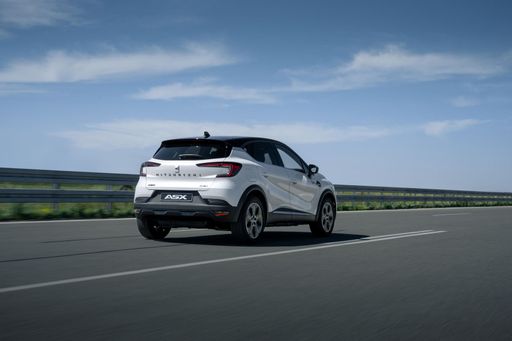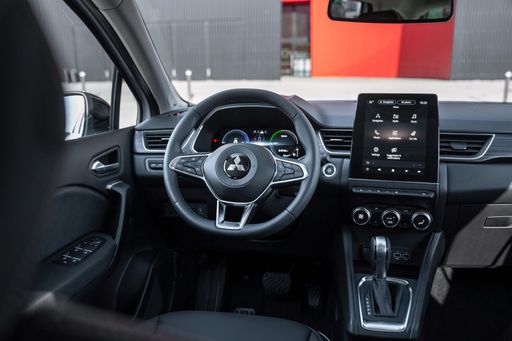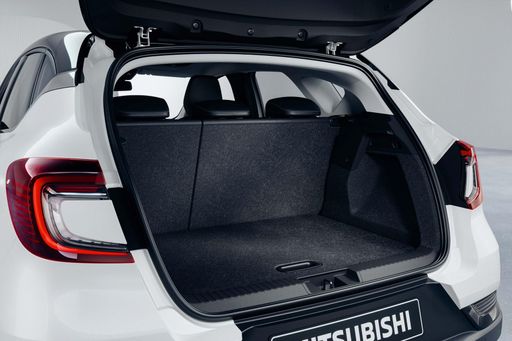When comparing two standout SUVs in the compact crossover segment, the Mitsubishi ASX and the SsangYong Torres provide an intriguing clash of features that cater to different lifestyles. With a focus on innovation, performance, and practicality, this article dives into the technical specifications and innovations that define these two models.
Mitsubishi ASX vs SsangYong Torres – Which model is better for everyday use?
Both models have their strengths – but which one suits you more?
Compare performance, efficiency, price and space directly: Mitsubishi ASX or SsangYong Torres?
Dimensions and Design: Space and Style
The Mitsubishi ASX boasts a compact yet spacious design, measuring 4239 mm in length, 1797 mm in width, and 1575 mm in height. It accommodates five passengers comfortably and showcases a trunk capacity of up to 484 liters, making it practical for everyday use.
On the other hand, the SsangYong Torres takes the lead in dimensions, measuring 4700 mm in length and 1890 mm in width, which offers extra space for occupants and gear with a trunk capacity of an impressive 703 liters. Standing taller at 1710 mm, the Torres provides a commanding road presence and a somewhat more spacious feel inside.
Engine Options and Performance
Mitsubishi offers the ASX with a variety of engine options including petrol, petrol MHEV, and full hybrid variants, with power outputs ranging from 91 to 158 HP. The ASX is well-equipped with automatic and manual transmission options, providing a smooth driving experience with up to 270 Nm of torque. The fuel efficiency is impressive, with averages between 4.7 to 6 L/100 km.
In contrast, the SsangYong Torres comes with robust options, boasting a petrol engine that produces up to 207 HP and torque ratings soaring to 339 Nm. Available in both front-wheel and all-wheel drive, it offers flexibility for various driving conditions. The fuel consumption ranges from 7.9 to 9.1 L/100 km, which is slightly higher than the ASX but compensates with performance. Furthermore, the Torres offers an electric variant with an electric range of up to 462 km, appealing to eco-conscious drivers.
Innovative Technologies
The Mitsubishi ASX embraces technology with features such as advanced driver assistance systems, connectivity options including smartphone integration, and a user-friendly infotainment system. The hybrid options come with a battery capacity of 0.6 kWh, which enhances efficiency while maintaining performance.
On the technology front, the SsangYong Torres shines with its innovative electric model, heralding a new era of eco-friendly driving. It includes advanced connectivity and driver-assistance features designed to enhance safety and convenience. The emphasis on electric capability not only reduces emissions but also offers modern drivers a future-ready vehicle with eco-consciousness at its core.
Comfort and Convenience
Both SUVs prioritize passenger comfort and practicality. The ASX, with its thoughtful interior layout, offers ample legroom and supportive seating for five. Its trim materials and technology features, while functionally focused, provide a comfortable driving environment.
In comparison, the Torres excels with more luxurious touches and superior roominess, making it ideal for families and those requiring more storage space. The refined design and additional tech features contribute to an overall more premium feel within the cabin.
Conclusion: Choosing the Right SUV
Ultimately, the choice between the Mitsubishi ASX and the SsangYong Torres will depend on individual preferences and driving needs. The ASX is suited for those seeking a blend of efficiency, comfort, and compact charm, whereas the Torres appeals to those looking for power, space, and cutting-edge electrical options.
In summary, both models showcase commendable engineering and innovation, each catering to distinct requirements, making them worthy competitors in today's competitive SUV market.
Here’s where it gets real: The technical differences in detail
Costs and Efficiency:
Looking at overall running costs, both models reveal some interesting differences in everyday economy.
Mitsubishi ASX has a convincingly advantage in terms of price – it starts at 20600 £, while the SsangYong Torres costs 33800 £. That’s a price difference of around 13286 £.
Fuel consumption also shows a difference: Mitsubishi ASX manages with 4.40 L and is therefore significantly more efficient than the SsangYong Torres with 7.90 L. The difference is about 3.50 L per 100 km.
Engine and Performance:
Power, torque and acceleration are the classic benchmarks for car enthusiasts – and here, some clear differences start to show.
When it comes to engine power, the SsangYong Torres has a distinct edge – offering 207 HP compared to 158 HP. That’s roughly 49 HP more horsepower.
In terms of top speed, the SsangYong Torres performs slight better – reaching 194 km/h, while the Mitsubishi ASX tops out at 180 km/h. The difference is around 14 km/h.
There’s also a difference in torque: SsangYong Torres pulls distinct stronger with 339 Nm compared to 270 Nm. That’s about 69 Nm difference.
Space and Everyday Use:
Beyond pure performance, interior space and usability matter most in daily life. This is where you see which car is more practical and versatile.
Both vehicles offer seating for 5 people.
In curb weight, Mitsubishi ASX is somewhat lighter – 1296 kg compared to 1498 kg. The difference is around 202 kg.
In terms of boot space, the SsangYong Torres offers evident more room – 703 L compared to 484 L. That’s a difference of about 219 L.
In maximum load capacity, the SsangYong Torres performs slight better – up to 1662 L, which is about 66 L more than the Mitsubishi ASX.
When it comes to payload, SsangYong Torres somewhat takes the win – 552 kg compared to 449 kg. That’s a difference of about 103 kg.
Who comes out on top?
Overall, the Mitsubishi ASX shows itself to be performs better in key areas and secures the title of DriveDuel Champion.
It convinces with the more balanced overall package and proves to be the more versatile choice for everyday use.

Mitsubishi ASX
Mitsubishi ASX
The Mitsubishi ASX presents itself as a compact crossover that combines practicality with style. Its sleek design and versatile interior make it an appealing choice for both urban and rural settings. With a focus on providing a comfortable driving experience, the ASX also offers a range of modern features that enhance connectivity and safety.
details @ Mitsubishi
@ Mitsubishi
 @ Mitsubishi
@ Mitsubishi
 @ Mitsubishi
@ Mitsubishi
 @ Mitsubishi
@ Mitsubishi
SsangYong Torres
The SsangYong Torres stands out with its rugged design and robust stance, ideal for adventure enthusiasts seeking a reliable companion for off-road escapades. Inside, the vehicle offers a spacious and comfortable cabin equipped with modern features to enhance the driving experience. Its performance is geared towards delivering a smooth ride, making it versatile for both city driving and rural trails.
details

|
|
|
|
|
Costs and Consumption |
|
|---|---|
|
Price
20600 - 32500 £
|
Price
33800 - 44600 £
|
|
Consumption L/100km
4.4 - 6 L
|
Consumption L/100km
7.9 - 9.1 L
|
|
Consumption kWh/100km
-
|
Consumption kWh/100km
18.70 kWh
|
|
Electric Range
-
|
Electric Range
462 km
|
|
Battery Capacity
-
|
Battery Capacity
-
|
|
co2
99 - 135 g/km
|
co2
0 - 207 g/km
|
|
Fuel tank capacity
48 L
|
Fuel tank capacity
50 L
|
Dimensions and Body |
|
|---|---|
|
Body Type
SUV
|
Body Type
SUV
|
|
Seats
5
|
Seats
5
|
|
Doors
5
|
Doors
5
|
|
Curb weight
1296 - 1493 kg
|
Curb weight
1498 - 1618 kg
|
|
Trunk capacity
348 - 484 L
|
Trunk capacity
703 L
|
|
Length
4239 mm
|
Length
4700 mm
|
|
Width
1797 mm
|
Width
1890 mm
|
|
Height
1575 mm
|
Height
1710 mm
|
|
Max trunk capacity
1458 - 1596 L
|
Max trunk capacity
1662 L
|
|
Payload
397 - 449 kg
|
Payload
552 kg
|
Engine and Performance |
|
|---|---|
|
Engine Type
Petrol, Petrol MHEV, Full Hybrid
|
Engine Type
Petrol, Electric
|
|
Transmission
Manuel, Automatic
|
Transmission
Manuel, Automatic
|
|
Transmission Detail
Manual Gearbox, Dual-Clutch Automatic, Automatic Gearbox
|
Transmission Detail
Manual Gearbox, Automatic Gearbox, Reduction Gearbox
|
|
Drive Type
Front-Wheel Drive
|
Drive Type
Front-Wheel Drive, All-Wheel Drive
|
|
Power HP
91 - 158 HP
|
Power HP
163 - 207 HP
|
|
Acceleration 0-100km/h
8.5 - 14 s
|
Acceleration 0-100km/h
-
|
|
Max Speed
168 - 180 km/h
|
Max Speed
191 - 194 km/h
|
|
Torque
160 - 270 Nm
|
Torque
280 - 339 Nm
|
|
Number of Cylinders
3 - 4
|
Number of Cylinders
4
|
|
Power kW
67 - 116 kW
|
Power kW
120 - 152 kW
|
|
Engine capacity
999 - 1789 cm3
|
Engine capacity
1497 cm3
|
General |
|
|---|---|
|
Model Year
2024 - 2025
|
Model Year
2023 - 2024
|
|
CO2 Efficiency Class
D, C
|
CO2 Efficiency Class
G, A
|
|
Brand
Mitsubishi
|
Brand
SsangYong
|
What drive types are available for the Mitsubishi ASX?
Available configurations include Front-Wheel Drive.
The prices and data displayed are estimates based on German list prices and may vary by country. This information is not legally binding.
